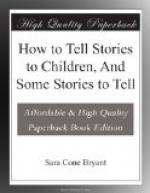A few generally applicable suggestions may, however, be useful,—always assuming the story-teller to have the fundamental qualifications of fine and wholesome habit. These are not rules for the art of speaking; they are merely some practical considerations regarding speaking to an audience.
First, I would reiterate my earlier advice, be simple. Affectation is the worst enemy of voice and enunciation alike. Slovenly enunciation is certainly very dreadful, but the unregenerate may be pardoned if they prefer it to the affected mouthing which some over-nice people without due sense of values expend on every syllable which is so unlucky as to fall between their teeth.
Next I would urge avoidance of a fault very common with those who speak much in large rooms,—the mistaken effort at loudness. This results in tightening and straining the throat, finally producing nasal head-tones or a voice of metallic harshness. And it is entirely unnecessary. There is no need to speak loudly. The ordinary schoolroom needs no vocal effort. A hall seating three or four hundred persons demands no effort whatever beyond a certain clearness and definiteness of speech. A hall seating from five to eight hundred needs more skill in aiming the voice, but still demands no shouting.
It is indeed largely the psychological quality of a tone that makes it reach in through the ear to the comprehension. The quiet, clear, restful, persuasive tone of a speaker who knows his power goes straight home; but loud speech confuses. Never speak loudly. In a small room, speak as gently and easily as in conversation; in a large room, think of the people farthest away, and speak clearly, with a slight separation between words, and with definite phrasing,—aiming your mind toward the distant listeners.
If one is conscious of nasality or throatiness of voice, it certainly pays to study the subject seriously with an intelligent teacher. But a good, natural speaking-voice, free from extraordinary vices, will fill all the requirements of story-telling to small audiences, without other attention than comes indirectly from following the general principles of the art.
To sum it all up, then, let us say of the method likely to bring success in telling stories, that it includes sympathy, grasp, spontaneity: one must appreciate the story, and know it; and then, using the realising imagination as a constant vivifying force, and dominated by the mood of the story, one must tell it with all one’s might,—simply, vitally, joyously.
CHAPTER V
SOME SPECIFIC SCHOOLROOM USES OF STORY-TELLING
In Chapter II., I have tried to give my conception of the general aim of story-telling in school. From that conception, it is not difficult to deduce certain specific uses. The one most plainly intimated is that of a brief recreation period, a feature which has proved valuable in many classes. Less definitely implied, but not to be ignored, was the use of the story during, or accessory to, the lesson in science or history.




